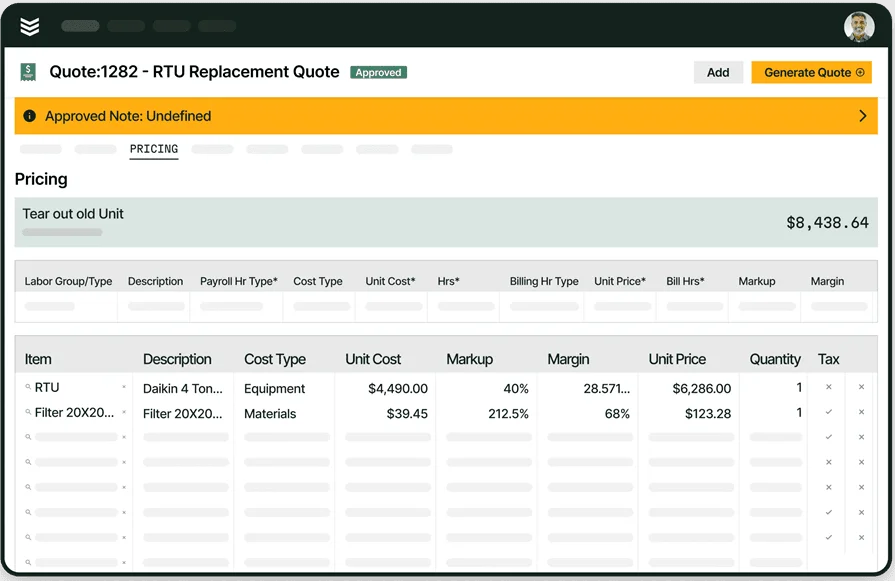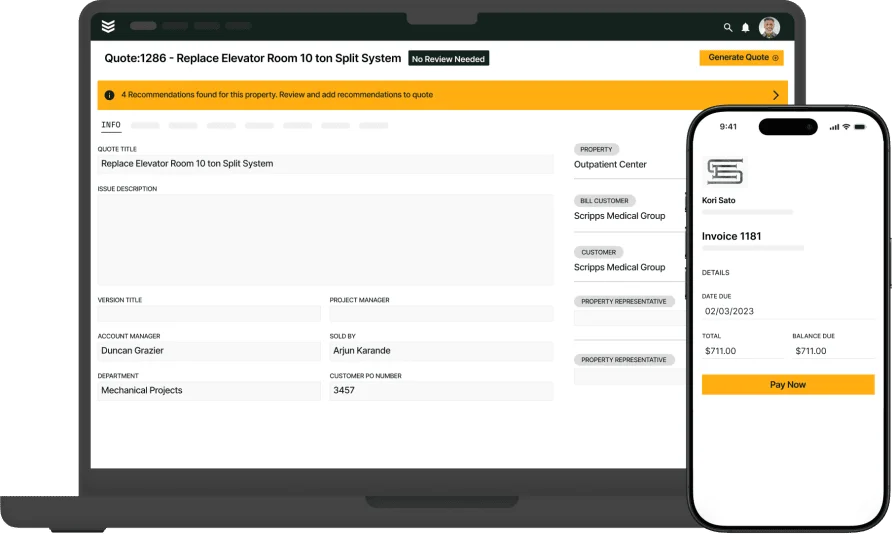Important
While BuildOps does not currently offer an HVAC price book, we’re always looking into new and exciting tools and technology that are moving the industry forward, which is why we’re discussing the subject here.
Whether you're running a tight team or managing a fleet of techs across multiple sites, having an HVAC industry resource like a price book can make or break your margins. If you're serious about locking in consistent pricing, cutting down on estimating errors, and speeding up your invoice cycle, a well-organized HVAC price book can be your best ally.
In this guide, we’ll break down everything you need to know about the HVAC pricing book, its models, its limitations, and how combining it with the right software can help you turn quotes into real profit. Here’s what we’ll cover:
- What is an HVAC price book?
- The two main HVAC pricing models
- The limitations of using an HVAC price book template
- 5 benefits of using an integrated price book with estimating and invoicing software
- How to maximize efficiency and profitability with an HVAC estimating and invoicing software
Before you jump into creating or updating your own HVAC pricing book, it’s important to understand what exactly it is, how it works, and where it fits into your day-to-day operations. Let’s start with the basics.
What is an HVAC price book?
An HVAC price book is a detailed list of standardized prices for services, repairs, and installs that is used to build quick, consistent estimates. It keeps job costs clear for techs and customers alike. With a good price book, your crew is guided and knows exactly what to charge on the spot.
An HVAC price book acts as your team’s go-to resource for quoting jobs, setting expectations with customers, and locking in profitable margins. It maps out every common task your techs handle—system tune-ups, compressor swaps, ductwork repairs—with clear, pre-set pricing. This way, when it’s time to quote or invoice, you’re not reinventing the wheel or second-guessing numbers.
It’s important to draw a line between a standard HVAC pricing book and a flat rate pricing book. While a general HVAC price book might list services based on hourly labor plus parts, an HVAC flat rate pricing book bundles everything—labor, materials, overhead—into one fixed, easy-to-present number. This flat rate model speeds up customer approvals, removes pricing debates, and can boost your close rates out in the field.
The two main HVAC pricing models
To go more into detail, once you have your HVAC price book set up, you’ll need to decide how you want to present your numbers to customers. In HVAC work, there are two major ways to price services: flat rate pricing and time & materials pricing. Each model comes with its own pros, cons, and best-use cases, depending on how you run your business.
- Flat rate: Flat rate pricing means giving customers one fixed price for a service, no matter how long the job takes. Everything—labor, parts, materials—is bundled into a single number listed in your HVAC flat rate pricing book. This approach helps techs quote jobs faster, keeps pricing predictable, and builds more trust with customers at the start of the job. Many contractors now use HVAC flat rate pricing software to manage and update these price books more efficiently, saving even more time in the field.
- Time & materials: The time and materials model charges customers based on actual labor hours plus the cost of parts and materials. It offers flexibility, especially for unpredictable or complex jobs, but it can lead to surprises for customers if the scope grows. This setup usually needs a more detailed HVAC pricing book to track labor rates and materials separately.
While both models have their place, relying solely on a basic price book template comes with challenges that can slow down your team and leave money on the table. Let’s dig into the limitations next.
The limitations of using an HVAC price book template
At first glance, an HVAC price book feels like the easy button. Build a list, set the prices, hand it to your techs—and boom, you're done. But out in the field, it's a different story. Static spreadsheets, printed templates, even some “digital” price books still slow crews down when it matters most.
Techs waste minutes flipping through codes or trying to match services to parts. If material prices jump, you’re stuck manually updating every line. If a job shifts midstream, quoting becomes a guessing game. Every delay pulls time away from getting jobs done—and from landing the next one.
Even when the price book is digital, the headache doesn't disappear. Most systems still leave your team building estimates from scratch, cross-checking line items, and double-checking labor rates. You’ve just swapped a three-ring binder for a browser window.
The bigger problem? Every extra click, every missing price, every wrong code means lost time and lost profit. Instead of solving problems for customers, your crew is stuck solving paperwork puzzles in the field. And when estimating takes longer, mistakes get baked into the job—and you feel it on the bottom line.
A static HVAC flat rate pricing book or a manually updated HVAC pricing book can't keep pace with the real-world chaos of commercial work. Techs prefer tools that let them pull prices instantly, update costs on the fly, and build quotes without slowing down.

See how real pros grow their business
Get insights into how contractors are able to achieve growth in the HVAC industry.
5 benefits of using an integrated price book with estimating and invoicing software
Running a busy HVAC business means you don’t have time for workarounds. Every extra step, every manual lookup, every wrong number costs time and cuts into profit. That’s why more contractors are connecting their HVAC price book directly into estimating and invoicing systems. Here’s what happens when you do.
1. Lock in estimates while you're still on-site
When your HVAC pricing book automatically feeds into your estimating tool, your techs don’t have to guess or call back to the office for pricing. They can pull real-time costs and hand a finished quote to the customer before packing up their tools. Systems like HVAC estimating software make this possible by tying labor rates, material costs, and service bundles directly into one workflow.
2. Eliminate costly errors before they start
Manual quoting means opening the door to mistakes—outdated rates, forgotten parts, or math slip-ups. By connecting your HVAC flat rate pricing book into the estimate and invoice process, you cut out double-entry errors. Everything flows cleanly from service selection to pricing, creating airtight quotes and cleaner bills. It’s why modern contractors are moving toward smarter systems instead of relying on outdated templates.
3. Get paid the moment the job wraps
Nothing drags down cash flow faster than delayed invoices. When your HVAC pricing book is tied directly into your invoicing system, techs can close out a job and trigger billing instantly—no waiting for office staff to catch up. A good HVAC invoicing guide shows how faster invoicing leads to tighter revenue cycles and fewer write-offs at the end of the month.
4. Keep pricing updated without re-training your entire crew
Material costs and labor rates don’t stand still. With an integrated system, you can update your HVAC price book across your entire team with just a few clicks. Nobody’s stuck working off old numbers, and there’s no need for constant meetings to roll out pricing changes. Solutions like HVAC invoicing software make sure every quote and invoice stays accurate without extra headaches.
5. Turn estimates into invoices without lifting a finger
Too often, shops lose money because the details in an estimate don’t match what ends up on the invoice. With the right setup, your estimate flows directly into your billing—no retyping, no missed services, no disputes. Some contractors even run the whole process off an estimate and invoice app built specifically for HVAC work, making it dead simple to close out a job from a smartphone or tablet.

Explore our quoting tool
Manage project estimates, scheduling, dispatching, and invoicing from one tool.
How to maximize efficiency and profitability with an HVAC estimating and invoicing software
Fast, accurate pricing can make or break your HVAC jobs. When your estimating and invoicing systems are connected to your HVAC price book, you cut out guesswork, slash turnaround times, and tighten up your margins. Here’s how top HVAC teams are using integrated systems to get more done with less chaos.
1. Use real-time pricing updates
Material prices don’t stay still. Your estimates need to pull the latest rates for parts, equipment, and labor automatically. Systems built for HVAC pricing software update rates in real-time, so your bids stay sharp—and your margins stay protected. When parts prices spike or drop, your quotes stay accurate without scrambling to update spreadsheets.
2. Build service packages to speed up quoting
Grouping common tasks into fixed service bundles—like a "spring A/C tune-up" or "heat pump install"—makes quoting simple. Using HVAC contract templates can also standardize service options and make it easier for customers to sign off quickly. It shortens the sales conversation and gets jobs scheduled faster.
3. Connect your estimates directly to invoices
When estimates and invoices live in the same system, the job details don’t get lost. What your tech quotes is exactly what the customer sees on the final bill. Integrated HVAC work order systems help ensure jobs move seamlessly from approval to completion without missing a beat. This kind of setup cuts out paperwork delays and billing errors.
4. Keep pricing synced with your inventory
If you quote a part that’s out of stock, you’re setting yourself up for callbacks and wasted trips. Cloud-based HVAC software lets you tie pricing directly to live inventory levels, so techs only quote parts and services you can actually deliver. Your crews stay focused on the work instead of scrambling for replacements last minute.
5. Train your techs to quote on the fly
Field quoting tools make it easy for techs to build and adjust estimates right from the truck. HVAC field service management platforms help techs pull service details, pricing, and availability without calling back to the office. Customers get quicker answers, and your team looks more confident and professional on every call.
6. Track estimate outcomes to sharpen performance
Good estimating tools don't just build quotes—they show you what’s working. Tying your quoting system into an HVAC CRM helps track customer interactions, follow up on proposals, and spot opportunities to tighten your sales process. You can see what’s closing fast, where you’re losing deals, and how to adjust on the fly.
7. Set pricing rules to protect your margins
Automated rules keep techs from accidentally underbidding jobs. Setting labor minimums, parts markups, and service floors directly inside your system makes sure that even quick quotes meet your business goals—without extra approvals or handholding. It locks in profit even when jobs change mid-stream or pricing conversations get tricky.
8. Pull service history into your quotes
When techs can see service history—what’s been fixed, what’s been upgraded—they build smarter, more profitable quotes. Connecting job history into your field tools helps crews suggest the right repairs or upgrades without wasting time or guessing. Customers see you’re paying attention to their equipment—not just selling them the next thing.
A strong HVAC price book helps shops quote faster, price smarter, and cut out the costly mistakes that pile up over time. But even the best static price book can't keep up with real-world changes like material price swings, job surprises, and customer expectations. That's why more contractors are moving toward systems that connect their HVAC pricing book directly into estimating, work orders, invoicing, and customer management—all in one place.
For commercial contractors who need a platform that handles not just pricing, but the full cycle from dispatch to closeout, BuildOps brings everything under one roof. It’s built to make everyday field service tasks easier, faster, and more profitable without layering on extra busywork.

Demo BuildOps’ pricing tool
See how we help teams tighten up quoting so they can keep cash flow moving.







